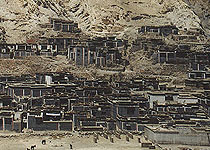| Travel in China > Protected Sites > Class Άρ > Constructions |
|
|
Sakya Monastery The Sakya Monastery is located at the foot of Benbo Mountain in the Tibet Autonomous Region.
The Zhongqu River runs through the temple and divides it into the southern temple and the northern temple. The northern temple has been mostly deserted and the southern temple still remains. Its walls were painted in red, white and grey strips, which represent Manjushri, Avalokiteshvara and Vajrapani respectively. Therefore, the Sakya Monastery is also called Colored Temple and Sakyapa sect is also called Colored School. The northern temple looks like a castle with walls as high as 13 meters surrounding it. It is a square with an area of 15,000 square meters. In the middle of the eastern side is a gate, on the top of which there is a watchtower. On the west, north and south, there is also a watchtower respectively. On the four corners of the wall, there are four turrets. Outside the castle is a lower earthen castle and outside further is the deep trench. Walls, watchtowers, turrets; earthen castle and trench form the defensive system of the castle, which was almost formidable at that time.
The main architectures inside the castle are the Dajing Hall, the Buddhism Hall and the hall where the Sakya archbishop lived. They all preserve the style of Yuan architectures. The Dajing Hall is in the center of the temple and occupies an area of 5,700 square meters. The columns and walls inside it are all painted dark red. There are 40 columns, each 10 meters high. On the western, northern and southern sides are fresco corridors while on the eastern side is the hall where Sakyapa Masters are enshrined. To the north of Dajing Hall is the hall for Sakyapa archbishop, with monks' dorms on its north and back.
On the shelves of the Dajing Hall and the Buddhism Hall are displayed various hand-written Buddhist scriptures and books of Ming and Qing dynasties. It has the largest number of books among all the temples in Tibet. These scriptures and books are precious materials for research into the Tibetan history. |
||||
All rights reserved. Reproduction of text for non-commercial purposes is permitted provided that both the source and author are acknowledged and a notifying email is sent to us. |
||||
 |
